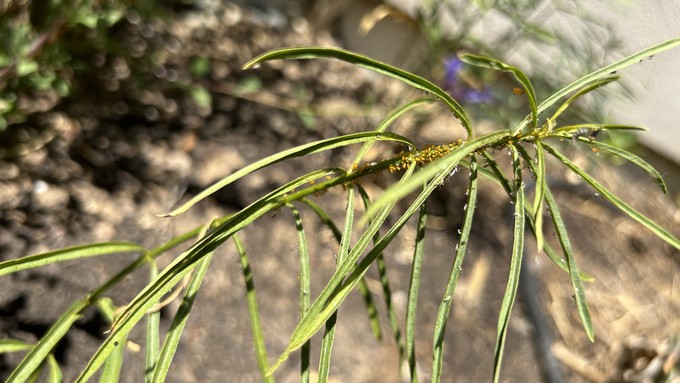
Sherwood hosts Open Garden Days; guided tour Saturday

Milkweed attracts aphids, too! The yellow dots on the stem are oleander aphids. Learn how to control those and other pests during Open Garden Days at the Sherwood Demonstration Garden. Kathy Morrison
Gardeners have lots of questions – especially this time of year.
On Friday and Saturday mornings, find answers during Open Garden Days at Sherwood Demonstration Garden in Placerville.
From 9 a.m. to noon on June 30 and July 1, the El Dorado County master gardeners will open Sherwood to the public for in-person and hands-on advice. Got a mystery plant or pest? Bring photos and, if possible, samples in zippered plastic bags.
Saturday, July 1, also features a docent-led guided tour of Sherwood’s 16 demonstration gardens. The tour starts promptly at 9 a.m. (If no one shows up, the docent leaves at 9:15.)
At Sherwood, master gardeners demonstrate research-based, sustainable gardening practices specific to the west slope of El Dorado County – but also applicable to other foothill and valley gardens. They teach by doing. Watch them at work on fruit trees or in the vegetable garden. In summer, the shade garden is especially popular with visitors.
Sherwood offers something for all ages and cultures, and reflects a variety of environments and gardening experiences, say the master gardeners. Its wide range of demonstration gardens feature plants and ideas that can be adapted to home landscapes.
Admission is free. No dogs allowed.
Sherwood Demonstration Garden is located at 6699 Campus Drive, Placerville, on the campus of Folsom Lake College’s El Dorado Center.
Details and directions: https://mgeldorado.ucanr.edu/.
Comments
0 comments have been posted.Sacramento Digs Gardening to your inbox.
Sites We Like
Garden Checklist for week of July 21
Your garden needs you!
* Keep your vegetable garden watered, mulched and weeded. Water before 8 a.m. to reduce the chance of fungal infection and to conserve moisture.
* Feed vegetable plants bone meal, rock phosphate or other fertilizers high in phosphate to stimulate more blooms and fruiting. (But wait until daily high temperatures drop out of the 100s.)
* Don’t let tomatoes wilt or dry out completely. Give tomatoes a deep watering two to three times a week.
* Harvest vegetables promptly to encourage plants to produce more. Squash especially tends to grow rapidly in hot weather. Keep an eye on zucchini.
* Pinch back chrysanthemums for bushy plants and more flowers in September.
* Remove spent flowers from roses, daylilies and other bloomers as they finish flowering.
* Pinch off blooms from basil so the plant will grow more leaves.
* Cut back lavender after flowering to promote a second bloom.
* It's not too late to add a splash of color. Plant petunias, snapdragons, zinnias and marigolds.
* From seed, plant corn, pumpkins, radishes, winter squash and sunflowers.